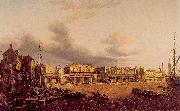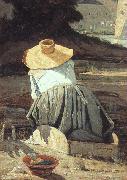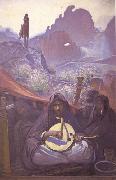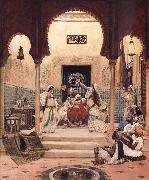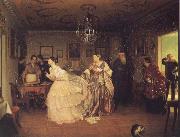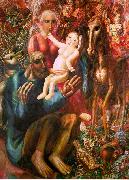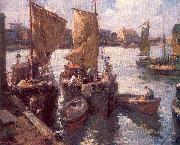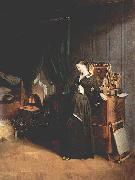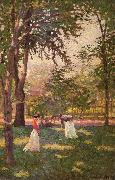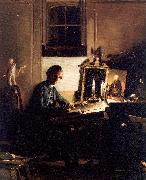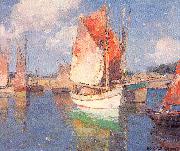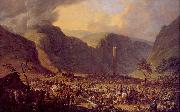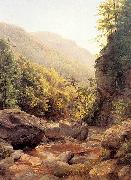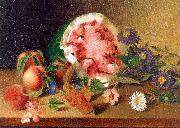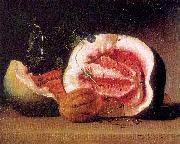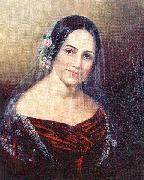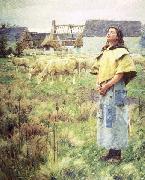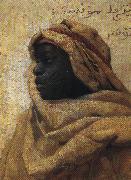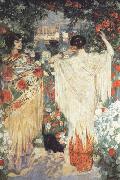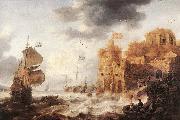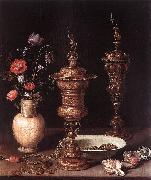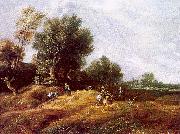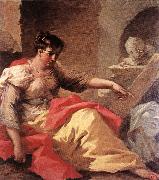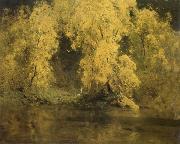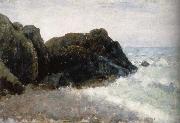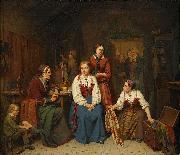|
|
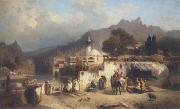 |
Paul von Franken
|
|
(1818- 1884 ) - Painter
painted Paul von Franken. View of Tiflis in 1866
|
|
|
|
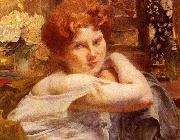 |
Paul-Albert Besnard
|
|
(2 June 1849 --4 December 1934) was a French painter and printmaker.
He was born in Paris and studied at the École des Beaux-Arts, studied with Jean Bremond and was influenced by Alexandre Cabanel. He won the Prix de Rome in 1874 with the painting Death of Timophanes
Until about 1880 he followed the academic tradition, but then broke away completely, and devoted himself to the study of colour and light as conceived by the Impressionists. The realism of this group never appealed to his bold imagination, but he applied their technical method to ideological and decorative works on a large scale, such as his frescoes at the Sorbonne, the Ecole de Pharmacie, the ceiling of the Comedie-Française (main theatre in Paris), the Salle des Sciences at the Hôtel de Ville, the mairie of the Ier arrondissement, and the chapel of Berck hospital, for which he painted twelve Stations of the Cross in an entirely modern spirit.
A great virtuoso, he achieved brilliant successes alike in watercolour, pastel, oil and etching, both in portraiture, in landscape and in decoration. His close analysis of light can be studied in his picture La femme qui se chauffe at the Luxembourg in Paris, one of a large group of nude studies of which a later example is Une Nymphe au bord de la mer; and in the work produced during and after a visit to India in 1911. A large panel, Peace by Arbitration, was completed seven days before the outbreak of war in 1914. |
|
|
|
|
|
|
|
|
|
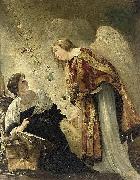 |
Paulus Bor
|
|
(Amersfoort, c. 1601 - Amersfoort, 10 August 1669) was a Dutch painter.
Bor was descended from a notable Catholic family. He made a study trip to Rome, where he was one of the founders of the Bentvueghels, taking the nickname Orlando. He returned in 1626 to Amersfoort and joined Jacob van Campen in the decoration of the palace Honselaarsdijk belonging to Frederik Hendrik. In 1656, he became regent of the godshuis "De Armen de Poth" in Amersfoort.
Bor's style of painting was rather at odds with that of contemporary painters from Utrecht. He initially painted rather Caravaggisti-like history paintings, but his works fast became marked by a classicism related to that of his townsman van Campen. Through unusual compositions and primitive technique, his paintings depict strange and mysterious subjects.
|
|
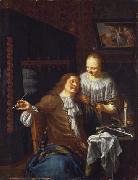 |
Paulus Moreelse
|
|
(1571, Utrecht - 6 March 1638, Utrecht) was a Dutch painter, mainly of portraits.
Moreelse was a pupil of the Delft portrait painter Michiel Jansz. van Mierevelt, who had himself been a pupil of Anthonie van Blocklandt. He took a study-trip to Italy, where he received many portrait commissions. Back in Utrecht, in 1596 he became a member of the zadelaarsgilde, which was the traditional name in Utrecht for the Guild of Saint Luke. In 1611, along with Abraham Bloemaert, he was one of the founders of a new painters' guild, called "St. Lucas-gilde", and became its first deken.
Moreelse was a well known portrait painter who received commissions from right across the Dutch Republic. His earliest work dates to 1606. Other than portraits, he also painted a few history paintings in the Mannerist style and in the 1620s produced pastoral scenes of herders and shepherds. He belonged to the same generation as Abraham Bloemaert and Joachim Wtewael, and like Wtewael he played an important role in the public life of their city. His version of Diana and Callisto was engraved by Jan Saenredam. In 1618, when the anti-remonstrants came to power in Utrecht, he was raadslid.
|
|
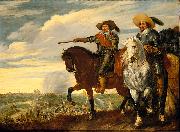 |
Pauwels van Hillegaert
|
|
(1596-1640) was a Dutch Golden Age painter of landscapes and military scenes.
He married Anneken Homis from Antwerp in 1620, with whom he had several children, including the painter with the same name, Pauwels van Hillegaert II (1621-1658). This Pauwels Jr. married Cornelia de Vlieger (daughter of Simon de Vlieger) and had two daughters. When Pauwels Jr. like his father died at a relatively young age, Cornelis de Bie wrote a commemorative poem about him.
Pauwels Sr. won royal commissions to paint battle scenes, most notably for the Siege of 's-Hertogenbosch in 1629. He also won a commission for the Battle of Nieuwpoort. He also painted Italianate landscapes, but was mostly admired for his horses and armor.
|
|
 |
Pavel Chistyakov
|
|
(July 5 1832 - November 11, 1919) was a Russian painter and teacher of art.
He studied at the St.Petersburg Academy of arts (1849-1861) under Petr Basin. He was a pensioner of the Academy of Arts in Paris and in Rome (1862 - 1870). He taught in the Drawing School of the Society for the Encouragement of the Arts (1860-1864), and in St.Petersburg (from 1872) he was the professor-head of workshop (1908-1910) and managing mosaic branch (1890-1912). The art-pedagogical system of Chistiakov, whose students included Viktor Vasnetsov, Mikhail Vrubel, Vasily Polenov, Ilya Repin, Valentin Serov, and Vasily Surikov, developed in constant struggle against the inert system of academism and played a huge role in the development of realism in Russian art of the second half of the 19th century.
The main goal of Chistiakov was the preparation of the artist-citizen possessing high professional skill. His pedagogical method assumed the merger of the direct perception of nature by the artist with its scientific study. In creative practice he aspired to dramatization of a historical plot and psychological saturation in historical and genre portraits (Head of a Ciucciara, 1864, in the Russian Museum, |
|
|
|
|
|
|
|
|
|
|
|
|
|
|
|
|
|
|
|
|
|
|
|
|
|
|
|
|
|
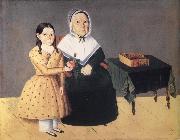 |
Peck Sheldon
|
|
American portrait painter and artist
b.1797 d.1868 |
|
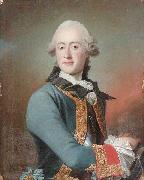 |
Peder Als
|
|
Peder Als, a Danish historical and portrait painter, born at Copenhagen in 1725, studied for some time under C. G. Pile. After gaining the first great prize given by the academy at Copenhagen in 1755, he went to Rome and entered the school of Mengs. He occupied himself chiefly in copying the pictures of Raphael and Andrea del Sarto, which it is said that he did with great accuracy. He also copied Correggio and Titian. On his return to his own country he painted some good portraits; but his colouring was too sombre to give a pleasing effect to his pictures of females, and his work was frequently so laboured as to be deprived of all animation. Copies of the works of the old masters by Als are to be seen in Denmark. He died in 1775. |
|
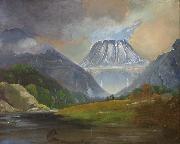 |
Peder Balke
|
|
Peter Andersen was born on the island of Helgøya, in Hedmark county, Norway. He grew up Ringsaker, but stayed in the 1820s on the Balke farm in Toten in Oppland county. Farmers in Toten paid his education, and as thanks he decorated several of the farms in Toten on his return. They actively encouraged his painting activities and later supported him in higher education.
In the autumn of 1827, Balke served as an apprentice to Heinrich August Grosch. he was also a student at the Tegneskole under Grosch and Jacob Munch. Balke signed a two year contract as an apprentice at the Danish decoration and artist Jens Funch. From autumn 1829 to spring 1833, he was a pupil of Carl Johan Fahlcrantz at the art academy in Stockholm. Balke was also a pupil of Johan Christian Dahl from 1843 to 1844.
During the summer of 1830 he walked through Telemark, Rjukan, Vestfjorddalen over Røldal and Kinsarvik to Bergen, and then back over Vossevangen to Gudvangen, further over Fillefjell to Valdres and thence across the mountains to Hallingdal. All the way he painted and drew small sketches that were later developed into paintings. He also traveled to Germany, and Russia. He visited Paris and London.
In Stockholm, he completed several of the paintings he had outlined of his Finnmark tour. Some of these were sold to the royal family. In 1846 he sold thirty of his paintings to Louis-Philippe of France for Versailles. Besides the 17 paintings in the National Gallery in Oslo, Peder Balke also is represented at several major art collections in Norway and Sweden.
|
|
|
|
|
|
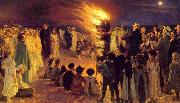 |
Peder Severin Kroyer
|
|
(23 July 1851 - 21 November 1909), known as P.S. Krøyer, was a Norwegian-Danish painter. He is one of the best known and beloved, and undeniably the most colorful of the Skagen Painters, a community of Danish and Nordic artists who lived, gathered or worked in Skagen, Denmark, especially during the final decades of the 19th century. Krøyer was the unofficial leader of the group.
|
|
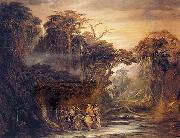 |
Pedro Americo
|
|
de Figueiredo e Melo (Areia, Brazil, 29 April 1843 - Florence, Italy, 7 October 1905) was one of the most important academic painters of Brazil. He was also a writer and a teacher.
He moved to Rio de Janeiro in 1854, where he was granted a scholarship to study in the Academia Imperial de Belas Artes (Imperial Academy of Fine Arts). Later he furthered his studies in Europe, at the École des Beaux-Arts in Paris, being a pupil of Jean-Auguste-Dominique Ingres, Hippolyte Flandrin and Carle-Horace Vernet, winning much praise for his paintings, and achieving the Doctorate in Sciences at the University of Brussels, in 1868.
Returning to Brazil, he produced a great series of masterpieces, including one of the most well known works of art in Brazil: Independence or Death!, depicting the moment when Prince Peter declared the country independent from Portugal, a work that has illustrated History books for elementary schools in Brazil for decades. Living mostly in Florence, Italy but traveling extensively back and forth from Rio de Janeiro, Pedro Am??rico managed to work also as a lecturer and an art historian.
He married Carlota de Ara??jo Porto-alegre (1844?C1918), daughter of painter and diplomat Manuel de Ara??jo Porto-alegre, and they had children. Knighted by the German Crown he was also Great Knight of the Order of the Holy Sepulchre. With the proclamation of the Republic in Brazil in 1889, he was elected a deputy of the National Assembly.
|
|
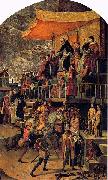 |
Pedro Berruguete
|
|
(c. 1450 - 1504) was a Spanish painter; his art is regarded as a transitional style between gothic and Renaissance. Born in Paredes de Nava, Spain, he went to Italy in 1480 and worked in Federigo da Montefeltro's court in Urbino, where he could see some works by Melozzo da Forle. He came back to Spain in 1482 and painted in several cities, such as Sevilla, Toledo and Ávila. He was the father of an important sculptor, Alonso Berruguete, considered the most important sculptor in Renaissance Spain.
|
|
|
|
 |
Pedro Figari
|
|
(June 29, 1861-July 24, 1938) was a Uruguayan painter, lawyer, writer, and politician. Although he did not begin the practice until his later years, he is best known as an early modernist painter who emphasized capturing the every-day aspects of life in his work. In most of his pieces, he attempts to capture the essence of his home by painting local customs that he had observed in his childhood.
Figari painted primarily from memory, a technique that gives his work a far more personal feeling. With his unique style, which involved painting without the intention to create an illusion, he, along with other prominent Latin-American artists such as Diego Rivera and Tarsila do Amaral, sparked a revolution of identity in the art world of Latin America.
|
|
 |
Pedro Weingartner
|
|
(Porto Alegre, 1853 - 1929) was an important Academic painter of Brazil, and the first artist born in Rio Grande do Sul to win international praise for his work.
Born to a family of German immigrants, he began his artistic career as an amateur, helped by his brother Inecio, who was a lithographer, and possibly also by painter Delfim da Câmara. Anyway, in 1878 he moved to Germany in order to study in the Grossherrzoglisch Badische Kunstschule, in Karlsruhe. There he became a pupil of Ferdinand Keller, Theodor Poeckh and Ernst Hildebrand. In 1880 Keller moved to Berlin, being followed by Weingärtner, who then enrolled in the local Academy.
In 1882 he left Germany for France, studying in the Academie Julian under Tony Robert-Fleury and William Adolphe Bouguereau. Wrecked by financial issues, he thought of abandoning his studies, but such situation was reverted by supportive friends, including Baron of Itajube, who got for him a special scholarship from emperor Peter II upon Bouguereau's advice. Then he could further his education in Rome.
Thereafter for many years he divided his time between Rio de Janeiro, Porto Alegre and Rome, traveling very often and being celebrated as one of the most important Brazilian painters of his generation. In Rio Grande do Sul he was a star. In 1920 he was back in Porto Alegre, where the remained until death. His fame declined from 1925 on, facing competition from new painters and changing tastes in local art. |
|
 |
Pedro Weingatner
|
|
Pedro Weingärtner (Porto Alegre, 1853 e 1929) was an important Academic painter of Brazil, and the first artist born in Rio Grande do Sul to win international praise for his work.
Born to a family of German immigrants, he began his artistic career as an amateur, helped by his brother Ineio, who was a lithographer, and possibly also by painter Delfim da Câmara. Anyway, in 1878 he moved to Germany in order to study in the Grossherrzoglisch Badische Kunstschule, in Karlsruhe. There he became a pupil of Ferdinand Keller, Theodor Poeckh and Ernst Hildebrand. In 1880 Keller moved to Berlin, being followed by Weingärtner, who then enrolled in the local Academy.
In 1882 he left Germany for France, studying in the Academie Julian under Tony Robert-Fleury and William Adolphe Bouguereau. Wrecked by financial issues, he thought of abandoning his studies, but such situation was reverted by supportive friends, including Baron of Itajube, who got for him a special scholarship from emperor Peter II upon Bouguereau's advice. Then he could further his education in Rome.
Thereafter for many years he divided his time between Rio de Janeiro, Porto Alegre and Rome, traveling very often and being celebrated as one of the most important Brazilian painters of his generation. In Rio Grande do Sul he was a star. In 1920 he was back in Porto Alegre, where the remained until death. His fame declined from 1925 on, facing competition from new painters and changing tastes in local art.
He devoted all his efforts to a half-Realist half-Romantic approach to Academicism even while such styles were already being severely challenged by Modern tendencies. Major themes in his work were mythological scenes, landscapes and genre paintings focusing mainly immigrants and the gaucho, the folk type of Rio Grande do Sul people.
|
|
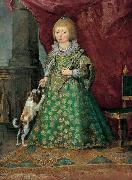 |
Peeter Danckers de Rij
|
|
Pieter, Peeter, or Peter Danckerts de Rij, Dankers de Ry, or Peteris Dankersas (1605, Amsterdam - 9 August 1661, Rudnik) was a Dutch Golden Age painter.
He was the son of Cornelis Danckerts de Ry, member of a large family of printers, painters and engravers.
Adam Kazanowski - by Peeter Danckers de Rij.
Example of Dankerts-Sandrart collaboration in print of PC Hooft. This 1642 engraving was painted by Sandrart, etched by Reinier van Persijn, and printed by Danckerts. The poem in Latin at the bottom was written by Caspar Barlaeus.Cornelis is mentioned in Houbraken's Schouburg as being one of the many teachers of Joachim von Sandrart in 1640-41, though considering Sandrart's age and experience (he had just returned to the North from his Grand Tour to Italy), this was more of a collaboration. Since Filippo Baldinucci later wrote a biograhical sketch on Pietro Danckerse de Ry in his list of artists called the Notizie, it is possible that Danckerts visited Italy at some time. In any case Sandrart engraved some of Peter's paintings after this period. Peter was active until 1640 in Amsterdam, and then he moved to Warsaw, Danzig, and Vilnius in the Polish-Lithuanian Commonwealth. He was active in Poland as the court painter and architect of the Polish King Władysław IV Vasa. According to Houbraken a poem was written in his honor that applauds his work in Poland. He died as the result of a highway robbery in the Redininkai Forest near Vilnius, Lithuania. |
|
|
|
|
|
|
|
|
|
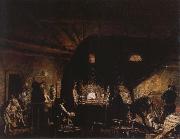 |
pehr hillestrom
|
|
Pehr Hilleström (1732-1816) var en svensk målare och vävare, professor vid Konstakademiens läroverk från 1794 och dess direktör från 1810. I unga år var han en av Sveriges främsta gobelängvävare men övergick sedan till måleri. Han är mest känd för sina vardagsskildringar av sin tids levnadssätt. Han målade pigor och tjänstefolk som arbetar, överklassen i de fina salarna, enkelt folk i stugorna och bilder från olika bruksmiljöer. Genom det räknas han som den största skildraren av den gustavianska samtiden.
Pehr Hilleström är far till konstnären Carl Petter Hilleström och farfars farfars far till Gustaf Hilleström.
Pehr Hilleström föddes i 1732 Väddö, Roslagen, troligtvis den 18 november. Han växte upp under fattiga omständigheter på Väddö prästgård vid sin farbror som var kyrkoherde där. Han var son till en militär och äldst i en syskonskara på 12 barn. Hans far råkade redan 1719 i rysk fångenskap men hade 1723 lyckats återvända till Sverige och då tagit sin tillflykt till brodern på Väddö.
1743 flyttade familjen Hilleström från Roslagen till Stockholm, där Pehr, 10 år gammal, sattes i lära hos tapet- och landskapsmålaren Johan Philip Korn (1727-1796) samt mellan åren 1744-1747 även hos den invandrade tyske solfjädermålaren Christian Fehmer. Utöver detta fick han även undervisning vid kungliga ritareakademin där Guillaume Thomas Taraval (1701-1750) och Jean Eric Rehn (1717-1793) var läromästare.
Efter inrådan från Carl Hårleman sattes Hilleström 1745 i lära hos Jean Louis Duru (-1753). Duru var hautelissevävare och hade kallats till Sverige för att göra textila utsmyckningen av Stockholms slott. Tanken var att Hilleström skulle utbildas till Durus medhjälpare. 1749 visade Hilleström upp ett första läroprov som visades upp för deputationen som gillade det så mycket så att han fick en belöning på 180 daler kopparmynt. När Duru dog i slutet av 1753 så fick Hilleström fullborda den påbörjade kappan för tronhimmelen i det kungliga audiensrummet. Han var då så skicklig att det knappt kunde märkas någon skillnad mellan hans och hans lärares arbete. Lönen var blygsam men vid 1756 års riksdag fick han samma årslön som Duru hade haft, och han fick en beställning på ett vävt porträtt av Hårleman utfört i hautelisse.
Åren 1757-58 var Hilleström på en längre och för tidens konstnärer sedvanlig studieresa till utlandet. Färden gick till Paris, Belgien och Holland, bland annat med en vidareutbildning i gobelängteknikerna som mål. I Paris blir Hilleström erbjuden att studera måleri i François Bouchers atelj??, men störst intryck tog han där av genre- och stillebenmålaren Jean-Baptiste-Sim??on Chardin, som undervisade honom vid franska målarakademien. Väl hemma i Stockholm fortsatte han visserligen att göra tapeter, mattor, stolsöverdrag och dylikt för hovet. Men så småningom fylldes slottet behov av vävnader samtidigt som Hilleström fortsatte studera måleri. |
|
 |
Pehr Horberg
|
|
was born January 31, 1746 in Virestad parish in Småland, Sweden and died January 24, 1816 in Risinge in Östergötland, Sweden, was a Swedish artist, painter and musician. In 1769 he married the maid Maria Eriksdotter and they had three sons.
Pehr Hörberg birthplace Virestad is a small town and a village in Älmhult Municipality in Kronoberg County, in Småland, Sweden. It was formerly the central area of the old Virestad parish. The church in Virestad was built of stone 1799-1800 on the site of a former medieval church. Some of its treasures include a pulpit from the 1600s and an altarpiece by Pehr Hörberg. He died in Falla in Hällestad Bergslag, where he owned 1/4 of the homestead, and part of the village Olstorp, in Risinge parish, where he also owned 1/4 of the homestead. Both the fourth in Falla in Hällestad and the fourth in Olstorp in Risinge were mining districts estates, located in Finspång Municipality in Östergötland County. Hörberg got his "huts in an aiding position", so to his own satisfaction that he 25 years later wrote about Olstorp and the farm in Falla, that he had later acquired, that the estates were very importat for him. |
|
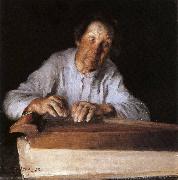 |
Pekka Halonen
|
|
Pekka Halonen (23 September 1865 - 1 December 1933) was a painter of Finnish landscapes and people. He was born in Lapinlahti. He lived with his family in a home and studio on Lake Tuusula in Järvenpää, Finland that he, himself, designed and named Halosenniemi. The beautiful and serene building is now a museum that includes original furnishings and Halonenes own art on the walls. There, on the shores of Lake Tuusula where Pekka Halonen resided, an artistse community developed and flourished, helping to develop a sense of Finnish national identity. Halosenniemi was designed with the two story studios of Paris in mind with high ceilings and tall windows in the studio and second floor living quarters accessible by a set of stairs and a balcony that overlooked the studio. Adjacent to the house, Halonen built a sauna and, in typical Finnish tradition, the sauna also served as a laundry. Halonen stated that he never painted for anyone but himself. He felt that eArt should not jar the nerves like sandpaper - it should produce a feeling of peace.e
His father was a peasant from Lapinlahti. Halonen studied at the Art Society's drawing school in Helsinki. In 1890 he moved to Paris where he studied at the Academie Julian and later under Paul Gauguin. He died in Tuusula.
There is a painting by Pekka Halonen in the post-impressionist section of the Museum of Fine Arts in Budapest, Hungary. Until May 2013 in the Groninger Museum, the Netherlands: Pekka Halonen, Eero Järnefeldt, Helene Schjerfbeck and Akseli Gallen Kallela in the exhibition 'Nordic Art: The Modern Breakthrough'. |
|
|
|
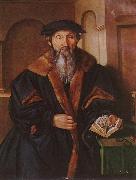 |
PENCZ, Georg
|
|
German Northern Renaissance Painter, ca.1500-1550 |
|
|
|
|
|
|
|
|








